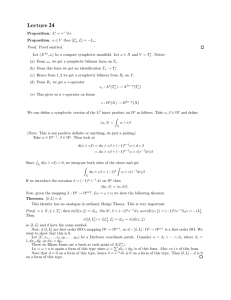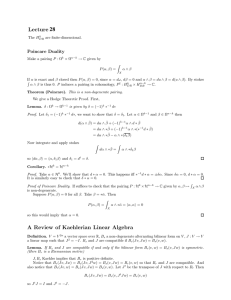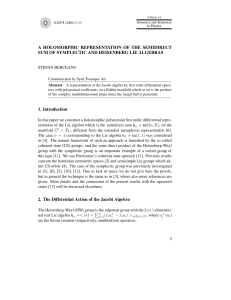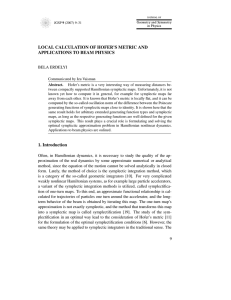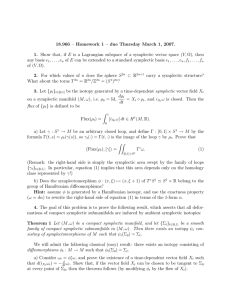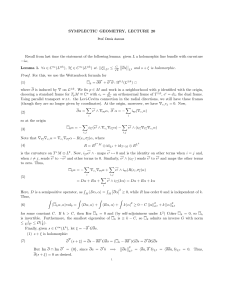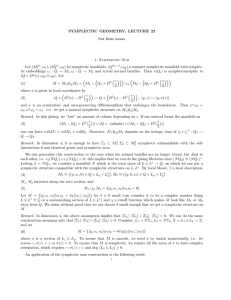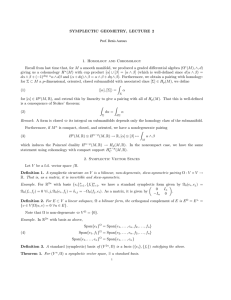Lecture 25 Symplectic Hodge Theory
advertisement
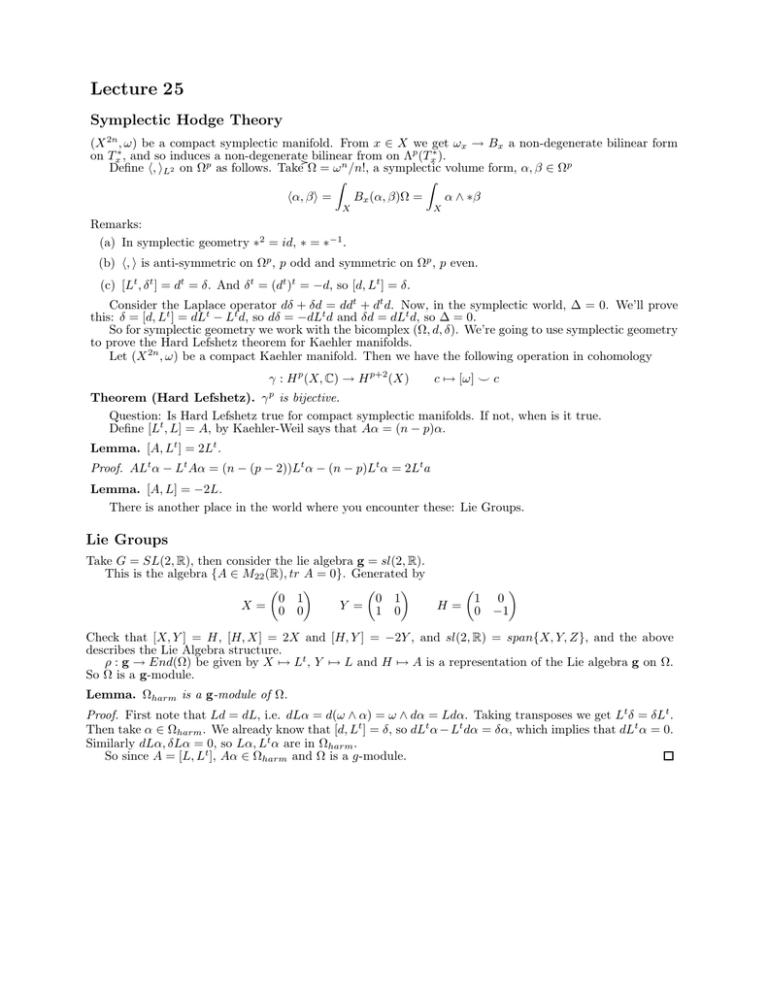
Lecture 25
Symplectic Hodge Theory
(X 2n , ω) be a compact symplectic manifold. From x ∈ X we get ωx → Bx a non-degenerate bilinear form
on Tx∗ , and so induces a non-degenerate� bilinear from on Λp (Tx∗ ).
Define h, iL2 on Ωp as follows. Take Ω = ω n /n!, a symplectic volume form, α, β ∈ Ωp
�
�
hα, β i =
Bx (α, β)Ω =
α ∧ ∗β
X
X
Remarks:
(a) In symplectic geometry ∗2 = id, ∗ = ∗−1 .
(b) h, i is anti-symmetric on Ωp , p odd and symmetric on Ωp , p even.
(c) [Lt , δ t ] = dt = δ. And δ t = (dt )t = −d, so [d, Lt ] = δ.
Consider the Laplace operator dδ + δd = ddt + dt d. Now, in the symplectic world, Δ = 0. We’ll prove
this: δ = [d, Lt ] = dLt − Lt d, so dδ = −dLt d and δd = dLt d, so Δ = 0.
So for symplectic geometry we work with the bicomplex (Ω, d, δ). We’re going to use symplectic geometry
to prove the Hard Lefshetz theorem for Kaehler manifolds.
Let (X 2n , ω) be a compact Kaehler manifold. Then we have the following operation in cohomology
γ : H p (X, C) → H p+2 (X)
p
c 7→ [ω] ⌣ c
Theorem (Hard Lefshetz). γ is bijective.
Question: Is Hard Lefshetz true for compact symplectic manifolds. If not, when is it true.
Define [Lt , L] = A, by Kaehler-Weil says that Aα = (n − p)α.
Lemma. [A, Lt ] = 2Lt .
Proof. ALt α − Lt Aα = (n − (p − 2))Lt α − (n − p)Lt α = 2Lt a
Lemma. [A, L] = −2L.
There is another place in the world where you encounter these: Lie Groups.
Lie Groups
Take G = SL(2, R), then consider the lie algebra g = sl(2, R).
This is the algebra {A ∈ M22 (R), tr A = 0}. Generated by
�
�
�
�
�
�
0 1
1 0
0 1
H = 0 −1
X= 0 0
Y = 1 0
Check that [X, Y ] = H, [H, X] = 2X and [H, Y ] = −2Y , and sl(2, R) = span{X, Y, Z}, and the above
describes the Lie Algebra structure.
ρ : g → End(Ω) be given by X 7→ Lt , Y 7→ L and H 7→ A is a representation of the Lie algebra g on Ω.
So Ω is a g-module.
Lemma. Ωharm is a g-module of Ω.
Proof. First note that Ld = dL, i.e. dLα = d(ω ∧ α) = ω ∧ dα = Ldα. Taking transposes we get Lt δ = δLt .
Then take α ∈ Ωharm . We already know that [d, Lt ] = δ, so dLt α − Lt dα = δα, which implies that dLt α = 0.
Similarly dLα, δLα = 0, so Lα, Lt α are in Ωharm .
So since A = [L, Lt ], Aα ∈ Ωharm and Ω is a g-module.
Note that Ωharm is not finite dimensional. So these representations are not necessarily easy to deal with.
Definition. Let V be a g-module. V is of finite H-type if
V =
N
�
Vi
i=1
and H = λi Id on Vi .
In other words, H is in diagonal form with respect to this decomposition.
�2n
�2n
p
.
Example. Ω = p=0 Ωp , H = (n − p)Id on Ωp and Ωharm = p=0 Ωpharm , H = (n − p)Id on Ωharm
Theorem. If V is a g-module of finite type, then every sub and quotient module is of finite type.
�N
Proof. V = i=1 Vi , H = λi Id on Vi . Let πi : V → Vi be a projection onto Vi . Check that
πi = �
�
1
(H − λj )
(λi − λj )
j=i
6
i.e., πi v = v on vi . So πi takes sub/quotient objects onto themselves.

